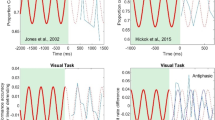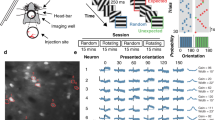Abstract
In everyday life we often encounter situations in which we can expect a visual stimulus before we actually see it. Here, we study the impact of such stimulus anticipation on the actual response to a visual stimulus. Participants were to indicate the sex of deer and cattle on photographs of the respective animals. On some trials, participants were cued on the species of the upcoming animal whereas on other trials this was not the case. Time frequency analysis of the simultaneously recorded EEG revealed modulations by this cue stimulus in two time windows. Early \(({\approx}100\,\hbox{ms})\) spectral responses \(({\approx}20\,\hbox{Hz})\) displayed strongest stimulus-locking for stimuli that were preceded by a cue if they were sufficiently large. Late \(({\approx}300\,\hbox{ms}, \ 40\,\hbox{Hz})\) responses displayed enhanced amplitudes in response to large stimuli and to stimuli that were preceded by a cue. For late responses, however, no interaction between cue and stimulus size was observed. We were able to explain these results in a simulation by prestimulus gain modulations (early response) and by decreased response thresholds (late response). Thus, it seems plausible, that stimulus anticipation results in a pretuning of local neural populations.









Similar content being viewed by others
References
Abbott LF, Chance FS (2005) Drivers and modulators from push–pull and balanced synaptic input. Prog Brain Res 149:147–155
Bar M (2007) The proactive brain: using analogies and associations to generate predictions. TRENDS Cogn Sci 11(7):280–289
Basar E, Schürmann M, Başar-Eroglu C, Demiralp T (2001) Selectively distributed gamma band system of the brain. Int J Psychophysiol 39:129–135
Basar-Eroglu C, Struber D, Schurmann M, Stadler M, Basar E (1996) Gamma-band responses in the brain: a short review of psychophysiological correlates and functional significance. Int J Psychophysiol 24(1–2):101–112
Bodis-Wollner I, Davis J, Tzelepi A, Bezerianos T (2001) Wavelet transform of the EEG reveals differences in low and high gamma responses to elementary visual stimuli. Clin Electroencephalogr 32(3):139–144
Busch NA, Debener S, Kranczioch C, Engel AK, Herrmann CS (2004) Size matters: effects of stimulus size, duration and eccentricity on the visual gamma-band response. Clin Neurophysiol 115(8):1810–1820
Busch NA, Herrmann CS, Müller MM, Lenz D, Gruber T (2006a) A cross-laboratory study of event-related gamma activity in a standard object recognition paradigm. NeuroImage 33:1169–1177
Busch NA, Schadow J, Fründ I, Herrmann CS (2006b) Time-frequency analysis of target detection reveals an early interface between bottom-up and top-down processes in the gamma-band. NeuroImage 29(4):1106–1116
Carandini M, Heeger DJ (1994) Summation and division by neurons in primate visual cortex. Science 264(5163):1333–1336
Chance FS, Abbott LF, Reyes AD (2002) Gain modulation from background synaptic input. Neuron 35:773–782
Chen AC, Herrmann CS (2001) Perception of pain coincides with the spatial expansion of electroencephalographic dynamics in human subjects. Neurosci Lett 297(3):183–186
Chun MM (2000) Contextual cueing of visual attention. TRENDS Cogn Sci 4(5):170–178
David O, Friston KJ (2003) A neural mass model for MEG/EEG: coupling and neuronal dynamics. NeuroImage 20:1743–1755
Debener S, Herrmann CS, Kranczioch C, Gembris D, Engel AK (2003) Top-down attentional processing enhances auditory evoked gamma band activity. NeuroReport 14(5):683–686
Desimone R, Albright TD, Gross CG, Bruce C (1984) Stimulus-selective properties of inferior temporal neurons in the macaque. J Neurosci 4(8):2051–2062
Eckstein MP, Shimozaki SS, Abbey CK (2002) The footprints of visual attention in the posner cueing paradigm revealed by classification images. J Vision 2(1):25–45
Fan J, Byrne J, Worden MS, Guise KG, McCandliss BD, Fossella J, Posner MI (2007) The relation of brain oscillations to attentional networks. J Neurosci 27(23):6197–6206
Finn IM, Priebe NJ, Ferster D (2007) The emergence of contrast-invariant orientation tuning in simple cells of cat visual cortex. Neuron 54(1):137–152
Fisher N (1993) Statistical analysis of circular data. Cambridge Universtity Press, New York
Freeman WJ (1975) Mass action in the nervous system. Academic Press, New York
Fries P, Reynolds JH, Rorie AE, Desimone R (2001) Modulation of oscillatory neuronal synchronization by selective visual attention. Science 291:1560–1563
Fründ I, Busch NA, Körner U, Schadow J, Herrmann CS (2007a) EEG oscillations in the gamma and alpha range respond differently to spatial frequency. Vision Res 47(15):2086–2098
Fründ I, Busch NA, Schadow J, Körner U, Herrmann CS (2007b) From perception to action: phase-locked gamma oscillations correlate with reaction times in a speeded response task. BMC Neurosci 8(27)
Fründ I, Schadow J, Busch NA, Körner U, Herrmann CS (2007c) Evoked gamma oscillations in human scalp EEG are test–retest reliable. Clin Neurophysiol 118(1):221–227
Fründ I, Busch NA, Schadow J, Gruber T, Körner U, Herrmann CS (2008) Time pressure modulates electrophysiological correlates of early visual processing. PLoS One 3(2):e1675
Gruber T, Müller MM (2005) Oscillatory brain activity dissociates between associative stimulus content in a repetition priming task in the human EEG. Cereb Cortex 15(1):109–116
Gruber T, Müller MM, Keil A (2002) Modulation of induced gamma band responses in a perceptual learning task in the human EEG. J Cogn Neurosci 14(5):732–744
Herrmann CS, Lenz D, Junge S, Busch NA, Maess B (2004a) Memory-matches evoke human gamma-responses. BMC Neurosci 5(13)
Herrmann CS, Munk MH, Engel AK (2004b) Cognitive functions of gamma-band activity: memory match and utilization. TRENDS Cogn Sci 8(8):347–355
Herrmann CS, Grigutsch M, Busch NA (2005) EEG oscillations and wavelet analysis. In: Handy TC (ed) Event-related potentials—a methods handbook, MIT Press, pp 229–259
Hoogenboom N, Schoffelen JM, Oostenveld R, Parkes LM, Fries P (2006) Localizing human visual gamma-band activity in frequency, time and space. NeuroImage 29(3):764–773
Howard MW, Rizzuto DS, Caplan JB, Madsen JR, Lisman J, Aschenbrenner-Scheibe R, Schulze-Bonhage A, Kahana MJ (2003) Gamma oscillations correlate with working memory load in humans. Cereb Cortex 13:1369–1374
Jansen BH, Rit VG (1995) Electroencephalogram and visual evoked potential generation in a mathematical model of coupled cortical columns. Biol Cybern 73:357–366
Jirsa VK, Haken H (1997) A derivation of a macroscopic field theory of the brain from the quasi-microscopic neural dynamics. Physica D 99:503–526
Karakaş S, Başar E (1998) Early gamma response is sensory in origin: a conclusion based on cross-comparison of results from multiple experimental paradigms. Int J Psychophysiol 31:13–31
Keil A, Müller MM, Gruber T, Wienbruch C, Elbert T (2001) Human large-scale oscillatory brain activity during an operant shaping procedure. Cogn Brain Res 12:397–407
Khoe W, Mitchell JF, Reynolds JH, Hillyard SA (2005) Exogenous attentional selection of transparent superimposed surfaces modulates early event-related potentials. Vision Res 45(24):3004–3014
Koch C (1999) Biophysics of computation. Oxford University Press, New York
Körner E, Gewaltig MO, Körner U, Richter A, Rodemann T (1999) A model of computation in neocortical architecture. Neural Networks 12:989–1005
Lachaux JP, George N, Tallon-Baudry C, Martinerie J, Hugueville L, Minotti L, Kahane P, Renault B (2005) The many faces of the gamma band response to complex visual stimuli. NeuroImage 25:491–501
Lai G, Mangels JA (2007) Cueing effects on semantic and perceptual categorization: ERPs reveal differential effects of validity as a function of processing stage. Neuropsychologia 45:2038–2050
Luck SJ, Hillyard SA, Mouloua M, Woldorff MG, Clark VP, Hawkins H (1994) Effects of spatial cuing on luminance detectability: psychophysical and electrophysiological evidence for early selection. J Exp Psychol Hum Percept Perform 20(4):887–904
Martinez A, Teder-Sälejärvi W, Vazquez M, Molholm S, Foxe JJ, Javitt DC, Di Russo F, Worden MS, Hillyard SA (2006) Objects are highlighted by spatial attention. J Cogn Neurosci 18(2):298–310
Mathes B, Strüber D, Stadler MA, Basar-Eroglu C (2006) Voluntary control of Necker cuber reversals modulates the EEG delta-and gamma-band response. Neurosc Lett 402(1–2):145–149
Miltner WHR, Braun C, Arnold M, Witte H, Taub E (1999) Coherence of gamma-band EEG activity as a basis for associative learning. Nature 397(6718):434–436
Morup M, Hansen LK, Herrmann CS, Parnas J, Arnfred SM (2006) Parallel factor analysis as an exploratory tool for wavelet transformed event-related EEG. NeuroImage 29(3):938–947
Naka KI, Rushton WA (1966) S-potentials from colour units in the retina of fish. J Physiol, London 185:584–599
Nunez PL, Srinivasan R (2006) Electric fields of the brain, 2nd edn. Oxford University Press, New York
Olufsen MS, Whittington MA, Camperi M, Kopell N (2003) New roles for the gamma rhythm: population tuning and preprocessing for the beta rhythm. J Comput Neurosci 14(1):33–54
Rennie CJ, Wright JJ, Robinson PA (2000) Mechanisms of cortical electrical activity and emergence of gamma rhythm. J Theor Biol 205:17–35
Reynolds JH, Chelazzi L (2004) Attentional modulation of visual processing. Annu Rev Neurosci 27:611–647
Robinson PA, Rennie CJ, Wright JJ (1997) Propagation and stability of waves of electrical activity in the cerebral cortex. Phys Rev E 56(1):826–840
Robinson PA, Wright JJ, Rennie CJ (1998) Synchronous oscillations in the cerebral cortex. Phys Rev E 57(4):4578–4588
Robinson PA, Rennie CJ, Wright JJ, Bahramali H, Gordon E, Rowe DL (2001) Prediction of electroencephalographic spectra from neurophysiology. Phys Rev E 63(021903)
Rodriguez E, George N, Lachaux JP, Martinerie J, Renault B, Varela FJ (1999) Perception’s shadow: long distance synchronization of human brain activity. Nature 397:430–433
Salinas E, Sejnowski TJ (2001) Gain modulation in the central nervous system: where behavior, neurophysiology, and computation meet. Neuroscientist 7:430–440
Schadow J, Lenz D, Thaerig S, Busch NA, Fründ I, Rieger JW, Herrmann CS (2007) Stimulus intensity affects early sensory processing: visual contrast modulates evoked gamma-band activity in human EEG. Int J Psychophysiol 66(1):28–36
Sederberg PB, Kahana MJ, Howard MW, Donner EJ, Madsen JR (2003) Theta and gamma oscillations during encoding predict subsequent recall. J Neurosci 23(34):10809–10814
Shimozaki SS, Eckstein MP, Abbey CK (2003) Comparison of two weighted integration models for the cueing task: linear and likelihood. J Vision 3(3):209–229
Spencer KM, Nestor PG, Perlmutter R, Niznikiewicz MA, Klump MC, Frumin M, Shenton ME, McCarley RW (2004) Neural synchrony indexes disordered perception and cognition in schizophrenia. Proc Natl Acad Sci USA 101(49):17288–17293
Tallon-Baudry C, Bertrand O (1999) Oscillatory gamma activity in humans and its role in object representation. TRENDS Cogn Sci 3(4):151–162
Tallon-Baudry C, Bertrand O, Delpuech C, Pernier J (1996) Stimulus specificity of phase-locked and on-phase-locked 40 Hz visual responses in human. J Neurosci 16(13):4240–4249
Tallon-Baudry C, Bertrand O, Delpuech C, Pernier J (1997) Oscillatory γ-band (30–70 hz) activity induced by a visual search task in humans. J Neurosci 17(2):722–734
Tallon-Baudry C, Bertrand O, Peronnet F, Pernier J (1998) Induced γ-band activity during the delay of a visual short-term memory task in humans. J Neurosci 18(11):4244–4254
Tiesinga PH, Fellous JM, Salinas E, José JV, Sejnowski TJ (2004) Inhibitory synchrony as a mechanism for attentional gain modulation. J Physiol (Paris) 98:296–314
Tiitinen H, Sinkkonen J, Reinikainen K, Alho K, Lavikainen J, Näätänen R (1993) Selective attention enhances the auditory 40-Hz transient response in humans. Nature 364:59–60
Uhlhaas PJ, Singer W (2006) Neural synchrony in brain disorders: relevance for cognitive dysfunctions and pathophysiology. Neuron 52(1):155–168
Vidal JR, Chaumon M, O’Regan JK, Tallon-Baudry C (2006) Visual grouping and the focusing of attention induce gamma-band oscillations at different frequencies in human magnetoencephalogram signals. J Cogn Neurosci 8(11):1850–1862
von Stein A, Sarntheim J (2000) Different frequencies for different scales of cortical integration: from local gamma to long range alpha/theta synchronization. Int J Psychophysiol 38:301–313
Wilson HR (1999) Spikes, decisions and actions. Dynamical foundations of neuroscience. Oxford University Press, New York
Yamaguchi S, Yamagata S, Kabayashi S (2000) Cerebral asymmetry of the “top-down” allocation of attention to global and local features. J Neurosci 20(RC72):1–5
Acknowledgements
This study was supported by the German Research Foundation (DFG, Grant HE3353/2-2). The authors acknowledge the funding by the Bernstein Group for Computational Neuroscience, Magdeburg. The authors would like to thank Christian Grasmé and Toralf Neuling for help with the data acquisition.
Author information
Authors and Affiliations
Corresponding author
Rights and permissions
About this article
Cite this article
Fründ, I., Schadow, J., Busch, N.A. et al. Anticipation of natural stimuli modulates EEG dynamics: physiology and simulation. Cognitive Neurodynamics 2, 89–100 (2008). https://doi.org/10.1007/s11571-008-9043-3
Received:
Revised:
Accepted:
Published:
Issue Date:
DOI: https://doi.org/10.1007/s11571-008-9043-3




